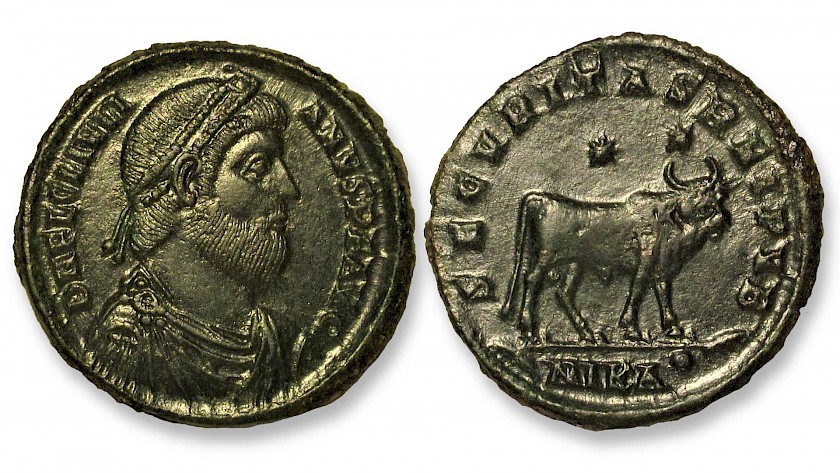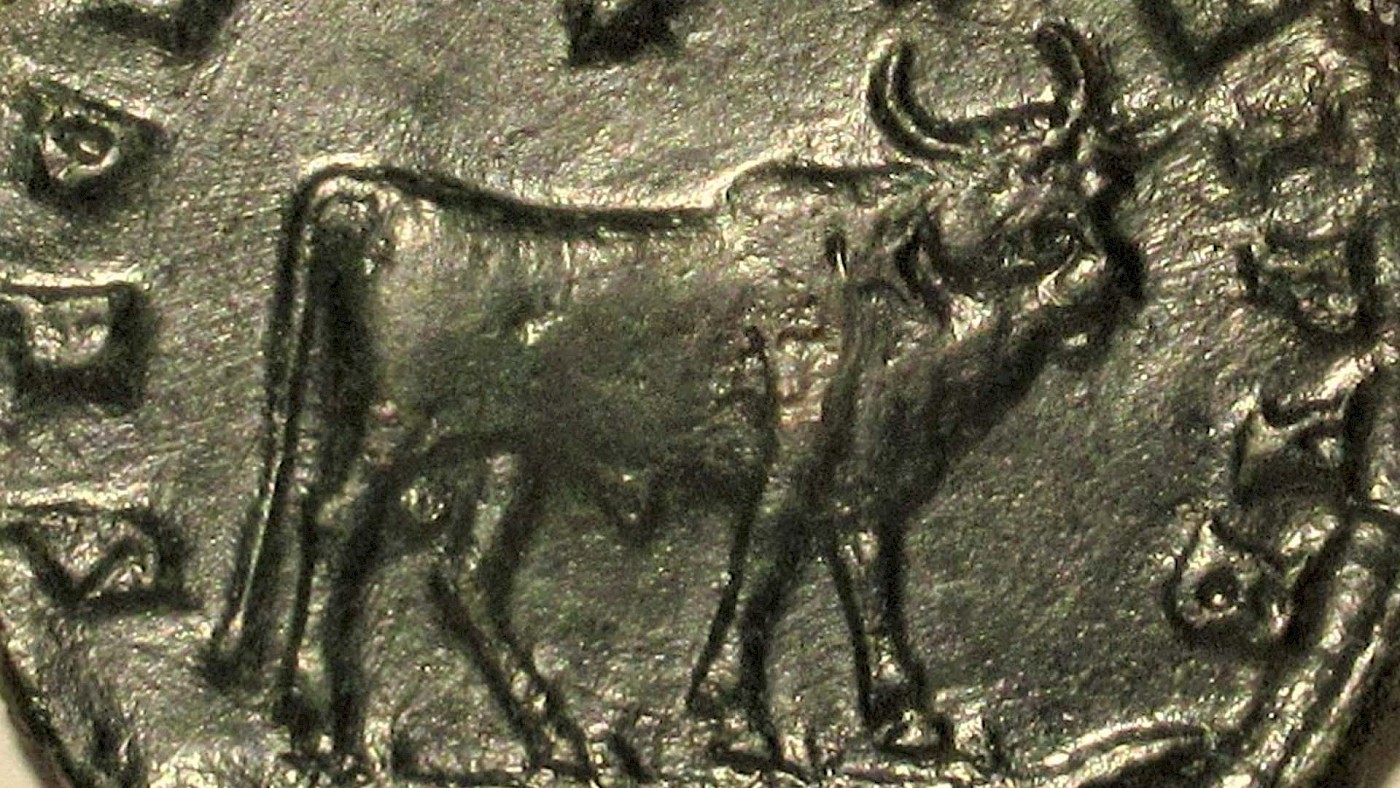Julian (r. AD 360–363) was never a conventional emperor. He saw himself as a philosopher and a thinker, who wanted nothing more than a life of studious contemplation. But as the last surviving relation of the formidable emperor Constantius II (the son of Constantine the Great), he was unwillingly forced into politics. This awoke an ambitious streak, which saw him eventually rebel against Constantius in AD 360 and seize power for himself.
Once in office, Julian systematically overturned the conventions of his predecessors. He embraced paganism after decades of Christian rule, earning himself the nickname “the Apostate”. He grew an unkempt beard, and ignored all the normal protocols for imperial behaviour. And he minted a very strange coin.
A curious coin
The obverse (or “heads”) shows Julian with his famous beard, a striking departure from his clean-shaven predecessors. The rest of the obverse – the robes, the jewelled crown, the legend – are all conventional for a fourth century coin. The reverse (or “tails”) also features familiar elements. There are the usual mint markings and the common legend SECVRITAS REI PVB, “the safety of the state.” But the picture itself is of a bull standing beneath two stars. It seems like an innocuous image, except that there had never been anything quite like it before.

What makes this coin really unusual is that even modern experts are unsure what its image is supposed to mean. Some have suggested it is a representation of the sun god Helios, who is often associated with the bull, or perhaps Mithras, famous for slaying a sacred bull. Others suggest it is the mythical Apis bull, with its roots in ancient Egypt. Yet more suggestions are that it represents the astrological sign, Taurus, or that the bull represents Julian himself. The sheer number of possible explanations is bewildering.
What makes it stranger is that Roman coin reverses almost always drew on a familiar repertoire of images, such as the goddess Victory or military scenes, which made coins easy to understand and interpret. So the obscurity or ambiguity of Julian’s bull coin marks it out from the herd. Was it simply the esoteric work of an emperor with an encyclopaedic knowledge of ancient myths and imagery? Or is it something more meaningful, the key to understanding one of the most enigmatic figures of the era?
The image of the bull
The difficulty here is that to understand what the bull means, we first need to ask who was choosing these images and who they were being aimed at. This is easier said than done. While numismatics, or “coin studies”, is an incredibly productive field, numismatists have little more to work with than the coins themselves.
While millions of ancient coins survive, strikingly few ancient writers ever comment on coins, and how they were made, and how they were perceived by the people who used them. Even a question as elementary as “Who actually decided what went on a coin?” is surprisingly difficult to answer. Did the emperor himself have any input at all?
In the case of Julian, it seems very likely that he did design the coins himself, if only because no one in the minting hierarchy would have proposed the unconventional iconography of beard and bull without the emperor’s eccentric influence. Yet what he was trying to say still eludes us. We know he – and indeed his predecessors – were fans of Helios, so that is certainly possible. But Julian also dabbled with Mithraism, and was actively searching for an Apis bull. With his convert’s enthusiasm for paganism, pretty much any ancient god or myth with a bull link is plausible. And as a man making a name for himself as a soldier emperor, fresh from a civil war and preparing for an invasion of Persia, it is equally possible Julian intended the bull comparison to be with himself.
Perhaps, then, we might make more headway by considering Julian’s audience. This is a difficult thing to consider, as we do not know how much attention the ancients usually paid to their coins. They may have used them simply as practical items of exchange, giving little thought at all to the carefully curated images. And indeed, for much of the empire the coins were hamstrung as a mode of communication because Latin was not widespread, and literacy even less so. Would a Greek-speaker from the East really care about a coin where even the alphabet seemed to exclude them from participating in its message?
Once again, there is no easy answer, but Julian’s mysterious bull coin gives another tantalising glimpse into the role of coins in the ancient world. While literary sources discussing coins are notoriously rare, one of these rare passages in Socrates Scholasticus actually tells a story about one city’s reaction to this very coin. Julian was visiting Antioch in Syria (now in southeast Turkey), where he spent the winter of AD 362 preparing for his invasion of Persia. He got on the wrong side of the locals with an ill-judged attempt at price controls, and (Socrates, Historia Ecclesiastica 3.17; transl. A.C. Zenos):
The Antiochenes not bearing the insult – for they are a people naturally impatient with insult – instantly broke forth into invectives against Julian, caricaturing his beard, which was a very long one, and saying that it ought to be cut off and manufactured into ropes. They added that the bull, which was impressed upon his coin, was a symbol of his having desolated the world. For the emperor, being excessively superstitious, was continually sacrificing bulls on the altars of his idols, and had ordered the impression of a bull and altar to be made on his coin.
Socrates makes an error describing the coin: none of Julian’s bull coins ever featured a sacrificial altar. Presumably Socrates, who was writing decades after Julian’s death, never saw the coin itself. He assumed, based on the Antiochenes’ joke about Julian’s sacrificial victims, that the coin did indeed depict a sacrifice scene. But the truth is rather more interesting. There is little on Julian’s coin to suggest sacrifice, and the mysterious stars seem to suggest something different. The Antiochenes’ humour comes from the fact that they knew this, and pretended to misinterpret it, twisting the reference to another, less positive aspect of his reign.
A bizarre text
The Antiochenes were taking Julian’s coin as an expression of what he personally wanted to say to his people, which is fascinating in itself. But even more so is Julian’s reaction. He should have simply laughed it off like his predecessors; being mocked by the mob was not unusual, and Julian should have known he would not be as popular with the Antiochenes as Constantius, who had made their city into a thriving imperial capital. Instead, he publicly published one of the most bizarre texts to survive from antiquity, nailing it outside the palace for everyone to see. This was the Misopogon, or “Beard-hater”.
The writings of Roman emperors are rare, with a small surviving corpus including such works as Augustus’ austere Res Gestae and Marcus Aurelius’ esteemed Meditations. Julian’s Misopogon does not make for easy company. It is a long and prickly diatribe in which he purports to satirise himself, while not-so-subtly pointing out the faults of the Antiochenes (Julian, Misopogon 338B-339B; transl. Wilmer C. Wright):
For criticising myself I have countless reasons, and first I will begin with my face. For though nature did not make this any too handsome or well-favoured or give it the bloom of youth, I myself out of sheer perversity and ill-temper have added to it this long beard of mine, to punish it, as it would seem, for this very crime of not being handsome by nature. For the same reason I put up with the lice that scamper about in it as though it were a thicket for wild beasts. As for eating greedily or drinking with my mouth open wide, it is not in my power; for I must take care, I suppose, or before I know it I shall eat up some of my own hairs along with my crumbs of bread. (…) But you say that I ought to twist ropes from it! Well I am willing to provide you with ropes if only you have the strength to pull them, and their roughness does not do dreadful damage to your “unworn and tender hands” [a quote from Odyssey 22.151] (…) But you emulate your sons and daughters by your soft and delicate way of living, or perhaps by your effeminate dispositions, and carefully make your chins smooth, and your manhood you barely reveal and slightly indicate by your foreheads, not by your jaws as I do.
This was not a dignified way for an emperor to behave. But it shows how much Julian cared about the insults to his coins (and his beard). “You insult your own sovereign,” he rants, “yes, even the very hairs on his chin and the devices engraved on his coins” (Misopogon 355D). To Julian, his coins were not just a way for him to speak to his people, but a way to speak with them. Their rejection of his coins, and the rejection of the aims and ideals they represented, was something he took extremely personally.
Julian never did make peace with Antiochenes, and died soon after, on 26 June 363. He was hit in the side by a spear during his dramatic invasion of Persia, and the Constantinian Dynasty died along with him. Perhaps something else also died with him: the knowledge of what a strange and playful image on a coin was truly supposed to mean, and its place in the great and doomed ambitions of the last pagan emperor.
